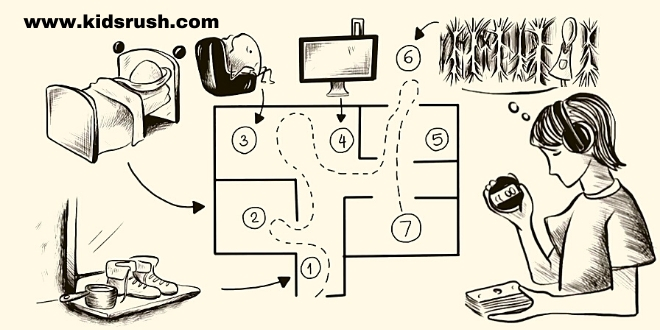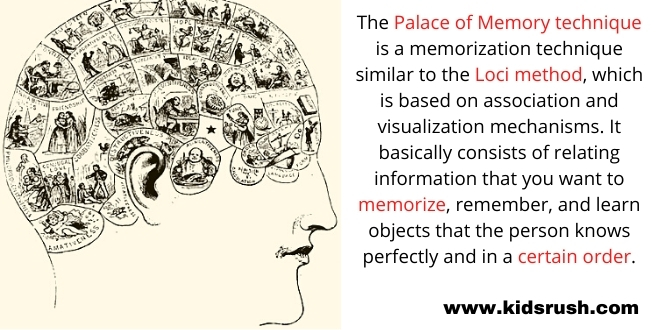How easy it would be to open a book and just by looking at it to be able to remember and memorize everything! Perhaps some privileged mind can do it, but for those who like me are not so lucky, there is the Palace of Memory, a technique that can help children learn easily and simply!
What is the Palace of Memory technique?

The Palace of Memory technique is a memorization technique similar to the Loci method, which is based on association and visualization mechanisms. It basically consists of relating information that you want to memorize, remember, and learn objects that the person knows perfectly and in a certain order.
What this method proposes is that each person creates in his head a house or a palace – the bigger the better – to divide it into rooms and each one of the rooms (must contain many elements) will be associated with the information that the person needs to memorize and learn.
For the result to be more effective, it is recommended to be inspired by a real and even known building because it will be easier to memorize the elements of it. Generally, everyone thinks of their house, even if it is small, but it is more familiar and recognizable.
Read Also: 4 ways to improve the sociability of children
How to teach your child to study with the Palace of Memory technique
And after this brief explanation, nothing better than an example to know how to put into practice the Palace of Memory technique with our children. We will give you a very simple exercise and, later, a more complicated one that can help you, for example, when you go to the supermarket to do your shopping.
Read Also: Activities to develop creativity in children
Exercise of the Palace of Memory for children
Imagine that in Geography and History class your child has been asked to learn the 5 continents used by the United Nations and by the International Olympic Committee, but to increase the difficulty that he must do it in alphabetical order: America, Europe, Africa, Asia, and Oceania.
Next, ask the little one to close his eyes and imagine that he is located in the door of the dining room of his house and the following animals and/or objects are placed there. At the entrance is the Statue of Liberty, which represents America; in the main hall is the Eiffel Tower, which is Europe; sitting on the sofa, there is a zebra, which is Africa; on the table, he comes across a Chinese dragon, which belongs to Asia, and, finally, on a chair, there is a kangaroo, which is Oceania.
Once the little one has drawn these elements in his living room, allow him a few minutes to drink water, and encourage him to tell you what was in his memory palace, to take that journey with his mind, he can even move around the room to help each other. How have you done it? It sure is great!
You can use this method when you have to learn the names of rivers, mountains, or writers and, for example, change rooms. That the names of rivers are in your room and each object you have there a different one. This way studying will be easier!
Read Also: Exercises to improve attention in children
Exercise of the Palace of Memory for parents
And, now, it will be you, mom or dad, the one who has to test their memory and their ability to remember everything. Imagine that you have to make the shopping list, but that you always lose the post-it where you write everything down and, of course, you end up taking what you should not and forgetting what you need. In this case, the Palace of Memory will be your great savior.
Imagine that this week you have to buy lentils, milk, bread, wet wipes, water, and cookies. Think about all the elements you have in the bathroom: mirror, bathtub, toilet, brush, shampoo, towel … Then you will begin to associate each product with one of the elements of the toilet; so when you see the mirror, a packet of lentils will be reflected in it; In the bathtub, you will only see milk (and not water), in the toilet you will not be able to sit because it will be full of loaves of bread; and when you want to take the brush, you will notice that there are wet wipes next to it … and so on.
If the first time you create your Memory Palace you notice that it is difficult for you to remember all the objects or concepts, you may have to practice a little more visualizations and associations, you should fill them with more details or involve other senses more.
Read Also: How to teach your baby to sit up by himself
Tips to get the most out of the Palace of Memory technique

This technique requires your practice because it is a way of studying, memorizing, and learning to remember is what your training requires, but once you start … you get hooked because of how effective it is! So that you can make the most of it, here are a series of tips:
- Build your Palace of Memory based on a place you know, because, as we have mentioned before, it will be easier for you to remember what is in it and move more easily. You will have a part of the path already done.
- Each room must contain different elements, otherwise, you could get confused. For example, if in the living room there is a television that we have associated with the name of a writer and in the bedroom, we also find another television, to which in this case we have associated with the name of a scientist, we may end up confusing them and let us give one the concept of the other.
- Our Palace of Memory should be easily explored. Nothing about having to go backward, going up and/or down many stairs, zigzagging, or jumping, because the only thing that will happen is that we will get lost.
- Each room has to contain many elements. For example, our room will consist of a bed, a chair, a wardrobe, a shelf, a coat rack … The more elements, the more concepts we can learn since we will have more “anchors” to assign an object.
Do we start practicing this technique to help children learn, study, and remember everything as if it were a game?
You may also like: How to teach children to be more organized
